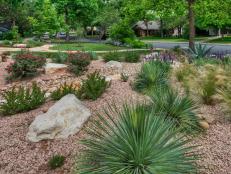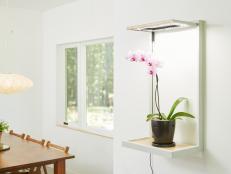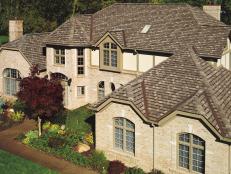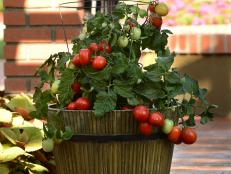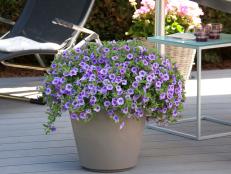Xeriscaping Plants
Plan an eco-friendly garden with xeriscaping plants. These water-savvy wonders save money and time and deliver big on beauty.

Stock your yard with xeriscaping plants to create a landscape that blends beauty with low water use. Many homeowners mistakenly associate xeriscaping plants with a desert-style garden, featuring cacti, yucca and agave. The fact is that xeriscaping plants run the gamut, from classic drought-tolerant succulents, to prairie plants, to ornamental grasses. Even cottage garden-type plants can sparkle in a xeriscape design.
Many xeriscaping plants feature adaptations to a drought-prone environment. Leaves or stems may be thicker to enable water storage. Plants with this characteristic are referred to collectively as succulents and include sedums (Sedum spp.), hens-and-chicks (Sempervivum tectorum), hardy ice plant (Delosperma cooperi) and the self-sowing annual moss rose (Portulaca grandiflora).
Another common xeriscaping plant feature is small leaves that may or may not be thick and fleshy. These diminutive leaves possess less surface area through which plants can lose water. Thyme (Thymus spp.) is a classic example of a small-leafed xeriscaping plant.
Other small-leafed, drought-tolerant plants include Corsican stonecrop (Sedum dasyphyllum), candytuft (Iberis sempervirens), moss phlox (Phlox subulata) and mossy saxifrage (Saxifraga x arendsii). As a few of the names suggest, many of these small-leafed beauties have moss-like features, which is a tell-tale clue that they make excellent ground cover plants.
Silver or gray-green leaves also hint that you’re facing a xeriscaping plant. Why silver leaves? They reflect the sun, shrugging at heat instead of wilting under it. This trait makes them stand-out xeriscaping plants. Silver leaves are typical of many Mediterranean plants—lavender (Lavandula spp.), Russian sage (Perovskia atriplicifolia), lavender cotton (Santolina chamaecyparissus), wormwood (Artemisia spp.) and lyme grass (Elymus arenarius ‘Blue Dune’).
Another branch of water miserly flora is the hairy-leafed plants. The hairs are actually a botanical adaptation that helps reduce water loss from leaves. Lamb’s ears (Stachys byzantina), snow-in-summer (Cerastium tomentosum), pussytoes (Antennaria plantaginifolia) and woolly yarrow (Achillea tomentosum) unfurl fuzzy leaves in shades of silver making them ideal xeriscaping plants.
Also consider prairie natives as you select xeriscaping plants. With deep root systems, prairie plants easily survive on rainfall once established. Many of these natives thrive on heat and bring movement and wonderful texture to a xeriscape garden design. Prairie natives that are also xeriscaping plants include blue wild indigo (Baptisia australis), compass plant (Silphium laciniatum), Husker Red penstemon (Penstemon digitalis ‘Husker Red’) and joe-pye weed (Eupatorium maculatum).
Also look to ornamental grasses to blend artful texture with low water use. Some prairie grasses you might want to consider are little bluestem (Schizachyrium scoparium), prairie dropseed (Sporobolus heterolepis), purple love grass (Eragrostis spectabilis) and blue grama (Bouteloua gracilis).
As you research xeriscaping plants, always select ones that are winter hardy in your zone. Many of these water-wise plants demand well-drained soil. Take time to amend soil in planting beds with compost or grit, which includes things like gravel, pulverized granite, terra-cotta pot pieces or builder’s sand.
Most xeriscaping plants boast drought-tolerance, but that low-thirst personality develops with age. Keep plants well-watered while they’re establishing in your landscape. The goal is to get plants root-established, where they’re actively sinking new roots into surrounding soil, before reducing irrigation. Many xeriscaping plants also require minimal care once established, which means your xeriscape design is not only eco-savvy, but low-maintenance as well.







